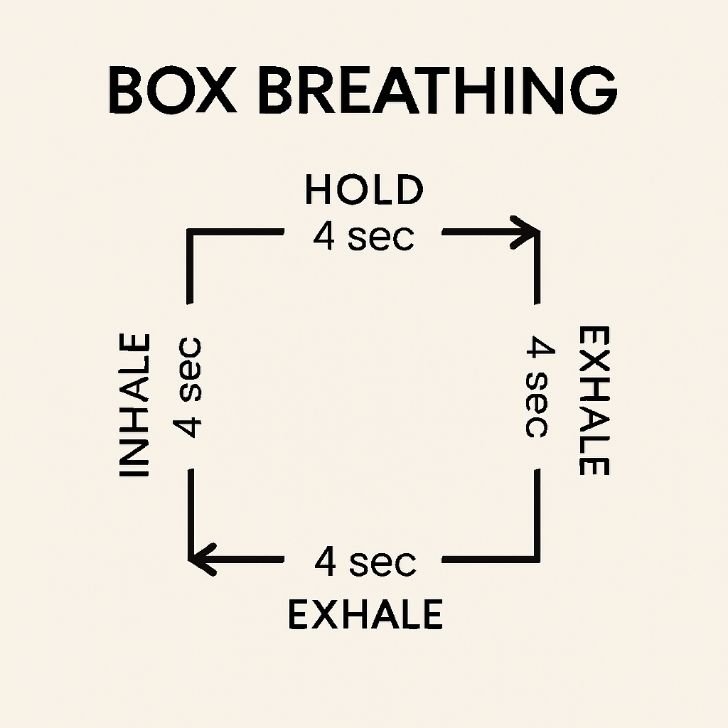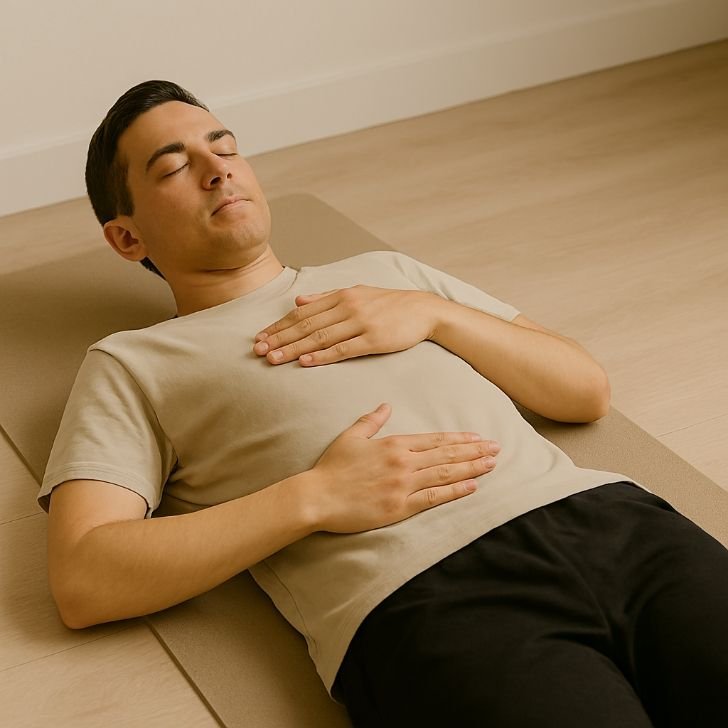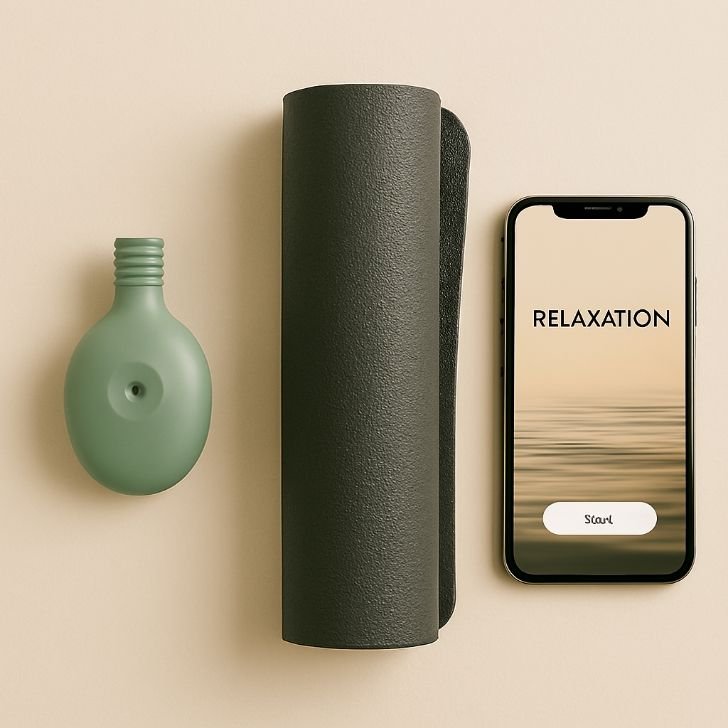Introduction
Many people search for effective breathing exercises that lower cortisol because stress impacts nearly every area of life.

If you feel stress all the time and your energy low, maybe your cortisol levels is higher than it should. Cortisol, the so-called “stress hormone,” plays a crucial role in how your body react to pressure. But too much cortisol? It cause poor sleep, anxiety, weight gain, even weaken your immunity. Many people think only medication or long therapy can help, but actually there are breathing exercises that lower cortisol very effective and accessible right now.
Breathing might sound too simple, but when you master it, it become one of the most powerful natural ways to lower cortisol fast. The rhythm of your breath signals the nervous system whether to activate stress response, or to return into calm healing mode.
In this guide, we dive deep into practical techniques like box breathing for stress, diaphragmatic breathing benefits, and yoga breathing for stress relief. You will also learn why breathwork is more than just air—it’s a lifestyle hack, a daily tool, and even a therapeutic bridge between body and mind.
Why Cortisol Matters
Cortisol is not always the enemy—it helps regulate blood pressure, metabolism, and even memory. The real problem starts when levels stay elevated for too long. Chronic stress means your adrenal glands are overworking, and that is when fatigue, weight gain, anxiety, and digestive issues show up. This is why breathing exercises that lower cortisol are so important: they don’t just calm your mind in the moment, they restore balance to your body’s natural rhythms. Imagine your breath as the volume knob of stress—turn it down, and the whole system begins to harmonize.
What Is Cortisol and Why Should You Care?
Cortisol is produce in adrenal glands. It helps regulate blood sugar, metabolism, inflammation, and even memory formation. A little cortisol is necessary for focus and alertness, but chronic stress keep this hormone elevated all day, making your body feel like it’s in survival mode nonstop.
When cortisol stays high, common symptoms appear:
Trouble falling asleep and staying asleep.
Gaining belly fat even when eating not too much.
Feeling restless, nervous, or irritated with small things.
Digestion problems like bloating or discomfort.
Reduced ability to focus or remember details.
That’s why finding natural ways to lower cortisol fast is essential. And breathing, unlike supplements or medications, is free and always with you.
How Breathing Exercises Lower Cortisol
Breathing is automatic, but also controllable. When stress rise, breathing becomes shallow and rapid. This signals the brain that danger is near, triggering the sympathetic nervous system (fight or flight). Controlled breathing, however, do opposite. It activate the parasympathetic nervous system (rest and digest), telling body it is safe.
Scientific research shows slow, deep breathing reduces blood pressure, lower heart rate, and yes, it directly reduce cortisol in bloodstream. When you practice breathing exercises that lower cortisol, your body begins to shift away from stress mode, creating space for relaxation, better sleep, and improved focus.
Best Breathing Exercises That Lower Cortisol
Here are simple yet powerful breathing hacks to calm your body and mind:
1. Box Breathing for Stress (a Navy SEAL Secret) – A Proven Breathing Exercise That Lowers Cortisol

Box breathing is famous technique used by Navy SEALs to stay calm under pressure. It’s structured, simple, and incredibly grounding.
How to do it:
1. Inhale slowly for 4 seconds.
2. Hold your breath for 4 seconds.
3. Exhale for 4 seconds.
4. Hold again for 4 seconds.
5. Repeat 4–6 rounds.
This steady rhythm creates mental focus and lowers stress quickly. Many people notice calmer heart rate after just 2 minutes. If stress spike during work or before sleep, this exercise works like pressing “reset button.”
Picture this: you’re about to walk into a stressful meeting or maybe you’re sitting in traffic with your heart racing. Instead of letting your body spiral into stress mode, you pause and try box breathing for stress. Four counts in, four counts hold, four counts out, four counts hold. Within two minutes, your racing heart slows, your hands feel less shaky, and your brain clears. Many Navy SEALs actually rely on this simple pattern during combat training—it’s proof that breathing exercises that lower cortisol can be powerful even under extreme pressure.
👉 Want a tool to make box breathing easier? Try a breathing trainer on Amazon 🛒.
2. Diaphragmatic Breathing Benefits

Also called “belly breathing,” diaphragmatic breathing use the diaphragm instead of shallow chest breaths. This type of breathing increase oxygen, improve lung efficiency, and significantly reduce cortisol.
How to do it:
Sit or lie down, put one hand on chest and the other on belly.
Inhale slowly so your belly rises, chest stay almost still.
Exhale gently, letting belly fall.
Continue for 5–10 minutes.
Diaphragmatic breathing benefits include better digestion, reduced anxiety, and even improved sleep quality. Some studies even link it to lower blood pressure and stronger immunity.
Research shows that diaphragmatic breathing stimulates the vagus nerve, which in turn reduces sympathetic nervous system activity (the fight-or-flight mode). This is one of the most natural ways to lower cortisol fast because it taps into your body’s built-in relaxation system. To make practice easier, many people use breathing trainers—small devices that give gentle resistance while you exhale, helping you strengthen your diaphragm. 👉 [Check this breathing trainer on Amazon]
👉 For deeper practice, many use yoga mats 🛒 for comfort while doing breathwork.
3. 4-7-8 Breathing (The Relaxation Formula)
Popularized by Dr. Andrew Weil, this exercise is nicknamed “the tranquilizer breath.”
Steps:
Inhale quietly through nose for 4 seconds.
Hold breath for 7 seconds.
Exhale with whoosh sound for 8 seconds.
Repeat up to 4 cycles.
This exercise is effective for people with insomnia or anxiety. Because it prolong exhale, it signals body to relax quickly.
4. Alternate Nostril Breathing (Nadi Shodhana)
In yoga, this practice balances left and right brain hemispheres.
Steps:
Sit comfortable. Use right thumb to close right nostril.
Inhale through left nostril.
Close left nostril with ring finger, exhale through right.
Inhale through right, close, exhale through left.
Continue cycle for 5 minutes.
Many yogis say this technique brings clarity, balance, and peace. Research support its ability to reduce stress and improve focus.
👉 Check yoga breathing guides on Amazon 🛒.
5. Simple Breathing Techniques for Anxiety
When anxiety hits suddenly, you don’t always have time for long practices. Here are quick hacks:
Sighing out loud: Take deep breath, then let out a big sigh with sound. Repeat 2–3 times.
Counting breath: Inhale while counting “one,” exhale “two,” continue to 10. Reset if distracted.
Hand on heart: Place hand gently on chest while breathing slowly. This creates instant comfort.
These are the simple breathing techniques for anxiety that you can practice even in public without anyone noticing.
6. Yoga Breathing for Stress Relief

Pranayama (yogic breathing) is a full system of techniques that goes beyond physical exercise. Practices like Bhramari (humming bee breath) and Ujjayi (ocean breath) bring calm and mental clarity.
Regular practice of yoga breathing for stress relief improves resilience, lowers cortisol, and cultivates mindfulness. When combined with yoga postures, the benefits multiply.
One simple way to integrate both is alternate nostril breathing (Nadi Shodhana) while holding a gentle Child’s Pose. This combination calms the nervous system, enhances oxygen circulation, and soothes the digestive tract—two areas often disrupted by high cortisol.
Another effective pairing is Cat-Cow stretches with Ujjayi breathing. The rhythmic spinal motion plus the ocean-like breath creates a deep relaxation response.
Studies suggest that yoga practitioners who weave breathwork into postures report up to 40% lower stress levels compared to those who rely on movement alone. This shows why breathing exercises that lower cortisol become especially powerful when combined with mindful movement.
7. Breathing Hacks for a Calm Mind
Sometimes the trick is not long sessions but quick hacks you sprinkle through day. Examples:
Exhale longer than inhale whenever you feel tension.
Use apps like Calm or Headspace for guided breathing.
Pair breathing with aromatherapy using lavender essential oil.
These breathing hacks for calm mind act like micro-breaks, keeping stress from building.
👉 Many people find relaxation apps gift cards 🛒 useful as motivation to stay consistent.
How to Make Breathing a Lifestyle Habit
Breathing practices should not be emergency tool only. To truly reset cortisol patterns, consistency is key. Here’s how:
Morning ritual: Start your day with 5 minutes of diaphragmatic breathing.
During work breaks: Instead of scrolling social media, try 2 rounds of box breathing.
Evening wind-down: Use 4-7-8 breathing before bed.
Combine with movement: Yoga, tai chi, or even mindful walking amplify effects.
Think of breath like nutrition—you don’t eat one healthy meal and expect transformation, you repeat daily. Same with breathing.
Imagine structuring a 24-hour cycle where breathing becomes as natural as brushing your teeth. 🌅
In the morning, instead of rushing straight to emails, sit by a window and do 10 slow rounds of diaphragmatic breathing. Let sunlight and oxygen wake your system together.
By midday, stress hormones often spike. Slipping in a box breathing for stress session during your coffee break works like hitting the reset button on your nervous system.
During the afternoon slump, try two minutes of breathing exercises that lower cortisol while standing and stretching. This lowers tension and boosts focus for the rest of your workday.
🌙 At night, unwind with yoga breathing for stress relief or the calming 4-7-8 technique while lying in bed. Many people report drifting off faster and sleeping more deeply when ending their day this way.
Over time, these micro-rituals train your body to regulate cortisol naturally and create a baseline of calm—no matter what challenges arise.
Natural Ways to Lower Cortisol Fast (Beyond Breathing)
Breathing is powerful, but holistic approach give even greater results. Other natural ways to lower cortisol fast include:
Prioritizing sleep hygiene.
Consuming adaptogens like ashwagandha and rhodiola.
Magnesium-rich foods for muscle relaxation.
Limiting caffeine and processed sugar.
Spending time in nature (proven to reduce cortisol in minutes).
👉 See our full guide on Leaky Gut Syndrome: Causes, Symptoms, and Healing to learn how gut health and stress are deeply connected.
Affiliate Product Suggestions
While breath is free, some tools, like breathing trainers or yoga mats, make it easier to practice breathing exercises that lower cortisol at home:
Breathing Trainers 👉 Check it on Amazon 🛒
Yoga Mats 👉 Shop on Amazon 🛒
Relaxation App Subscriptions 👉 Buy gift cards on Amazon 🛒

Internal Link
🌱 Breathing is powerful for stress relief, but gut health also plays a critical role in cortisol balance. For a deeper dive, check out our main guide:
👉 Leaky Gut Syndrome: Causes, Symptoms, and Healing
Conclusion
Stress is not going away in modern life. But your reaction to it can change dramatically. By practicing breathing exercises that lower cortisol, you train your nervous system to choose calm instead of chaos. From box breathing for stress to diaphragmatic breathing benefits, from simple breathing techniques for anxiety to yoga breathing for stress relief, you now hold tools that can transform daily living.
So don’t wait for stress to overwhelm. Start small—one deep breath, one calming practice. Your body is listening, and with every breath, cortisol lowers, mind clears, and energy returns.
Remember: Breathing is free, portable, and available at any moment. Yet so many overlook it as a tool for real stress relief. If you commit to just 10 minutes daily of breathing exercises that lower cortisol, you may notice better sleep, improved focus, and even healthier digestion. The breath you take today is the stress relief you feel tomorrow.

